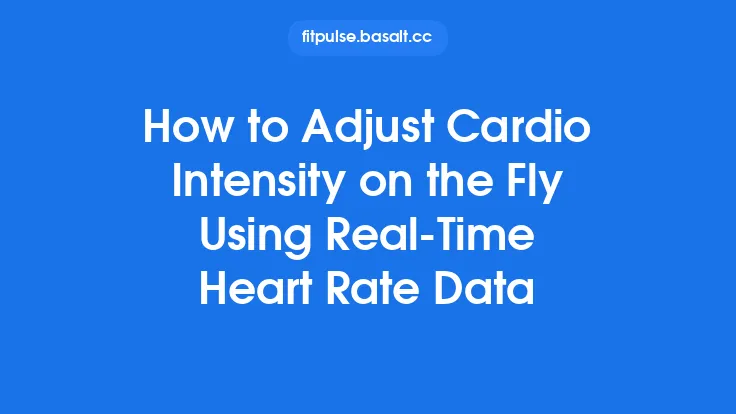The relationship between altitude and the body’s cardiovascular responses is a cornerstone of exercise physiology, yet it often goes unnoticed by users of modern fitness trackers. When you ascend from sea level to a higher elevation, the reduced partial pressure of oxygen forces the heart and respiratory system to work harder to deliver the same amount of oxygen to working muscles. This shift has direct consequences for two of the most widely tracked biometric metrics: heart rate (HR) and maximal oxygen uptake (VO₂ max). Understanding how altitude alters these measurements is essential for anyone who trains, competes, or simply monitors health in mountainous regions, at high‑altitude training camps, or even during occasional hikes.
The Physiology of Altitude Exposure
At sea level, atmospheric pressure is roughly 760 mm Hg, and the fraction of oxygen (O₂) is about 21 %. The resulting partial pressure of oxygen (pO₂) in the alveoli is sufficient to saturate hemoglobin (Hb) at ~97‑99 %. As elevation rises, barometric pressure drops, and so does alveolar pO₂. For example, at 2,500 m (≈8,200 ft) the barometric pressure is about 560 mm Hg, reducing alveolar pO₂ by roughly 30 %. The immediate physiological response includes:
- Increased Ventilation (Hyperventilation): The respiratory centers stimulate a higher breathing rate to raise alveolar O₂ and expel CO₂.
- Elevated Sympathetic Activity: Catecholamine release (epinephrine, norepinephrine) raises heart rate and contractility to maintain cardiac output.
- Acute Hemoconcentration: Plasma volume contracts, raising hematocrit and blood viscosity, which can affect stroke volume.
- Shift in the Oxygen‑Hemoglobin Dissociation Curve: Acidosis from hyperventilation (respiratory alkalosis) initially shifts the curve left, improving O₂ loading, but renal compensation later shifts it right, facilitating O₂ unloading at the tissue level.
These acute changes are followed by longer‑term adaptations (acclimatization) such as increased erythropoietin production, expanded capillary density, and mitochondrial efficiency improvements. Both phases—acute and chronic—modulate HR and VO₂ max in distinct ways.
How Altitude Alters Heart Rate
1. Resting and Submaximal Heart Rate
Even at rest, the heart beats faster at altitude. The typical increase ranges from 5 to 15 bpm at 1,500 m, scaling up to 20‑30 bpm at elevations above 3,000 m. This rise is primarily driven by sympathetic stimulation and reduced stroke volume due to lower plasma volume. Consequently, submaximal exercise HR for a given workload (e.g., jogging at 8 km/h) will be higher than at sea level.
2. Maximal Heart Rate (HRmax)
The classic formula HRmax = 220 − age is derived from sea‑level data. Research shows that HRmax can increase modestly (≈5‑10 bpm) at moderate altitudes (1,500‑2,500 m) but may plateau or even decline at extreme elevations (>4,500 m) where cardiac output becomes limited by reduced preload and increased afterload. The variability is large, making it risky to rely on a single HRmax estimate across different elevations.
3. Heart Rate Variability (HRV) Considerations
While HRV is a separate topic, it is worth noting that altitude reduces parasympathetic tone, leading to lower HRV indices. This effect can confound interpretations of training load if the same HRV thresholds are applied at sea level and high altitude.
Altitude’s Impact on VO₂ Max
VO₂ max is defined as the maximal rate at which an individual can uptake, transport, and utilize oxygen during intense exercise. It is expressed in milliliters of O₂ per kilogram of body weight per minute (ml·kg⁻¹·min⁻¹). Altitude influences each component of this cascade:
- Pulmonary Diffusion: Lower alveolar pO₂ reduces the gradient for O₂ diffusion into blood, decreasing arterial O₂ content (CaO₂).
- Cardiac Output: Acute sympathetic activation can raise cardiac output, but the reduced stroke volume often offsets this gain, especially at higher elevations.
- Peripheral Extraction: Muscular O₂ extraction may improve with acclimatization (increased capillary density, mitochondrial adaptations), partially compensating for lower delivery.
Empirically, VO₂ max declines by roughly 6‑8 % for every 1,000 m increase in altitude during the acute phase. For instance, a sea‑level VO₂ max of 55 ml·kg⁻¹·min⁻¹ may drop to ~45 ml·kg⁻¹·min⁻¹ at 2,500 m. After 2‑3 weeks of acclimatization, the decrement is often reduced to 3‑5 % because of hematological and muscular adaptations.
Measurement Challenges at Altitude
1. Sensor Accuracy and Calibration
Most consumer wearables estimate VO₂ max using algorithms that combine HR, speed, and demographic data. These models are calibrated on sea‑level datasets; they do not account for reduced oxygen availability. Consequently, the derived VO₂ max values at altitude are typically underestimates of the true sea‑level capacity, but they may still be useful for tracking relative changes if the same altitude is maintained.
Heart‑rate sensors (optical PPG or chest‑strap ECG) are generally robust to altitude, but peripheral vasoconstriction can diminish PPG signal quality, especially in cold mountain environments. Chest straps remain the gold standard for accurate HR at altitude.
2. Barometric Pressure Compensation
Some devices incorporate barometric altimeters to adjust for elevation when calculating pace or distance. However, few adjust HR‑based metrics for the physiological impact of reduced pO₂. Users should be aware that a “VO₂ max” reading from a smartwatch taken at 2,500 m is not directly comparable to a reading taken at sea level without manual correction.
3. Data Normalization Strategies
Researchers often normalize altitude VO₂ max values to sea‑level equivalents using the Fick equation:
\[
\text{VO₂}{\text{SL}} = \text{VO₂}{\text{ALT}} \times \frac{\text{CaO₂}{\text{SL}}}{\text{CaO₂}{\text{ALT}}}
\]
where CaO₂ is arterial oxygen content, calculated from hemoglobin concentration, oxygen saturation (SaO₂), and the oxygen‑binding capacity of hemoglobin. By measuring SpO₂ (via pulse oximetry) and hemoglobin (via a blood test), one can approximate the sea‑level VO₂ max from an altitude test.
Device Calibration and Algorithm Adjustments
Manufacturers are beginning to embed altitude‑aware algorithms. Key approaches include:
- Incorporating Barometric Data: Using the built‑in barometer to adjust the expected maximal HR and VO₂ max curves.
- Dynamic SpO₂ Integration: Some newer wearables feature continuous SpO₂ monitoring; this data can be fed into VO₂ max estimations to correct for hypoxic stress.
- Machine‑Learning Models: Training models on large datasets collected at multiple elevations allows the algorithm to learn altitude‑specific patterns in HR‑pace relationships.
For users, the practical tip is to verify whether the device’s firmware includes altitude compensation. If not, manually apply correction factors (e.g., subtract 6 % per 1,000 m from the reported VO₂ max) for a more realistic comparison.
Practical Recommendations for Athletes and Recreational Users
- Acclimatize Before Testing: Allow at least 7‑10 days at the target altitude before performing a VO₂ max or HRmax test. This reduces the acute hypoxic shock and yields more stable values.
- Standardize Testing Conditions: Conduct measurements at the same time of day, after similar sleep and nutrition patterns, and in comparable environmental temperatures.
- Use Chest‑Strap HR Monitors: For high‑intensity sessions at altitude, a chest strap mitigates the risk of PPG signal loss due to peripheral vasoconstriction.
- Record SpO₂ Simultaneously: Pair HR data with SpO₂ readings to enable post‑hoc correction of VO₂ max estimates.
- Track Relative Changes, Not Absolute Numbers: When training across multiple elevations, focus on trends (e.g., “HR for a given pace is 8 bpm higher at 2,000 m”) rather than raw VO₂ max values.
- Adjust Training Zones: If you rely on HR zones for intensity prescription, recalculate zones based on the observed HRmax at the current altitude rather than sea‑level predictions.
- Hydration and Nutrition: Altitude induces diuresis; maintaining plasma volume helps preserve stroke volume and limits excessive HR elevation.
Interpreting Data Across Different Elevations
| Elevation (m) | Expected Resting HR ↑ (bpm) | Approx. HRmax Change | VO₂ max Decline (Acute) |
|---|---|---|---|
| 0 (sea level) | 0‑2 | Baseline | 0 % |
| 1,500 | +5‑10 | +5‑8 | –6 %‑8 % |
| 2,500 | +10‑15 | +5‑10 | –12 %‑16 % |
| 3,500 | +15‑20 | +0‑5 (possible ↓) | –18 %‑22 % |
| 4,500+ | +20‑30 | –5‑0 (possible ↓) | –24 %‑30 % |
Values are averages from peer‑reviewed studies; individual responses vary.
When comparing two sessions—one at 500 m and another at 2,500 m—subtract the expected HR increase (≈10 bpm) from the high‑altitude reading to approximate the sea‑level equivalent. Similarly, apply the percentage VO₂ max decline to adjust the reported value.
Future Directions in Altitude‑Sensitive Tracking
- Integrated Barometric‑SpO₂ Sensors: Combining pressure and oxygen saturation in a single module will enable real‑time correction of VO₂ max estimates.
- Personalized Acclimatization Models: Using longitudinal data (HR, SpO₂, performance) to predict an individual’s rate of adaptation and suggest optimal training loads.
- Cloud‑Based Calibration: Uploading altitude‑tagged workouts to a central server where machine‑learning algorithms refine correction factors for each device model.
- Hybrid Wearables: Pairing wrist‑based optical sensors with a lightweight chest‑strap that transmits raw ECG data to the wrist unit, preserving comfort while ensuring accuracy.
These innovations aim to close the gap between laboratory‑grade cardiopulmonary testing and everyday fitness monitoring, making altitude‑adjusted metrics as reliable as sea‑level ones.
Key Takeaways
- Altitude reduces ambient oxygen pressure, prompting immediate increases in heart rate and decreases in VO₂ max. The magnitude of change is roughly 6‑8 % VO₂ max loss per 1,000 m during the acute phase.
- Heart‑rate monitors remain accurate, but optical sensors can suffer from peripheral vasoconstriction. Chest‑strap ECG devices are preferred for high‑intensity work at elevation.
- Consumer VO₂ max algorithms are typically calibrated for sea level. Users should apply correction factors or use SpO₂ data to approximate sea‑level equivalents.
- Acclimatization mitigates the altitude effect. After 2‑3 weeks, VO₂ max loss often halves, and HR responses become more stable.
- Practical training adjustments—recalibrating HR zones, tracking relative changes, and ensuring proper hydration—help maintain performance and safety when training at altitude.
By recognizing how altitude reshapes the cardiovascular landscape, fitness enthusiasts and athletes can interpret their biometric data more intelligently, tailor training programs to the environment, and ultimately achieve better outcomes—whether they are scaling a mountain summit or simply logging a weekend hike.





